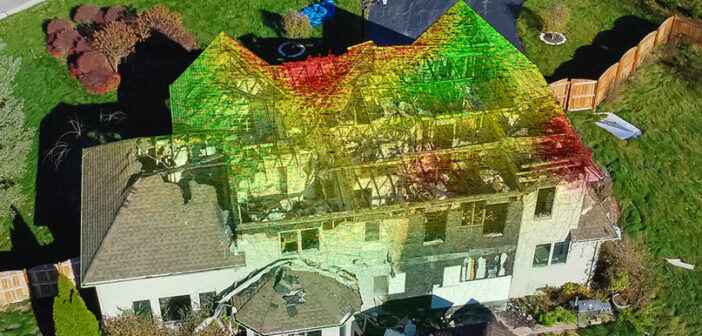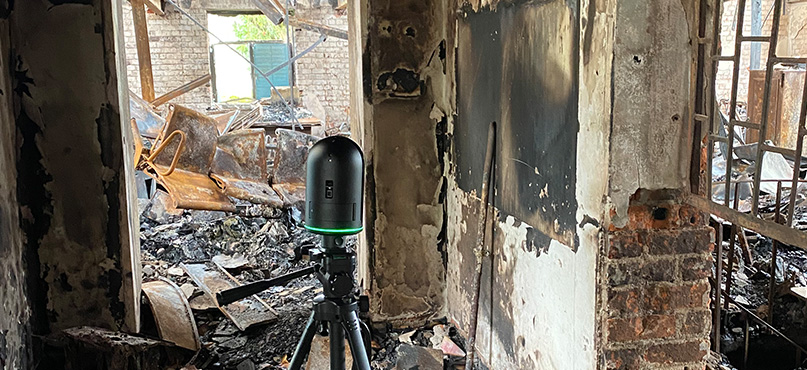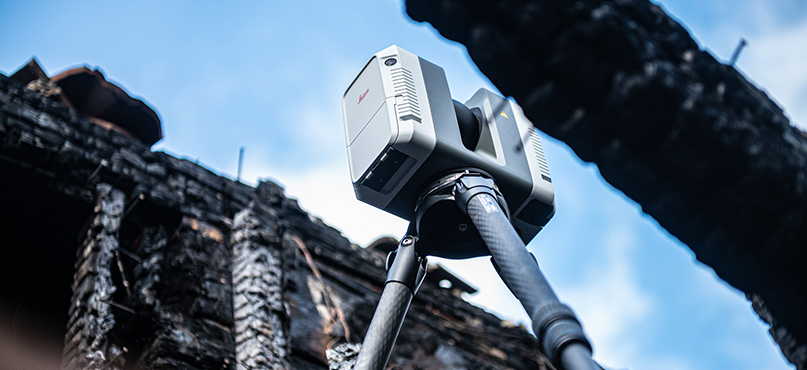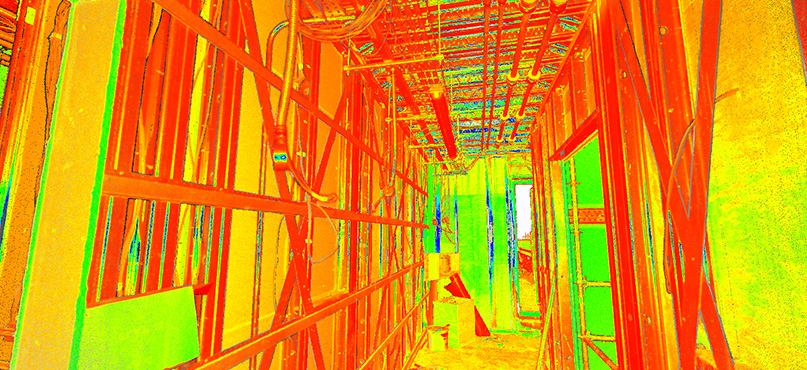There’s a lot at risk when it comes to fire, arson, or an explosion. The lives of victims at the scene during the fire, the emergency response teams during the rescue operation, the fire investigators in the aftermath, and crucial evidence within the burnt infrastructure that is needed to secure a verdict of the incident in court.
Fire and explosion investigators and forensic experts have much to contend with to gather and protect evidence, or even entire scenes, to ensure justice, safety, and possibly prevention in the long term. Moreover, they need to work quickly and efficiently to protect themselves and others at the scene and to capture, seize and secure vital evidence at the scene. In this blog, we answer the burning questions about how reality capture technology can be deployed at every stage of a fire investigation workflow, from capturing and documenting the scene in 3D to managing the data and delivering compelling reports.
Capture the fire scene in 3D
Reality capture technology offers a safe, efficient and accurate way to document fire or explosion scenes. Without the technology, police officers and fire investigators rely on a traditional approach using 2D sketches, photographs, and a tape measure to capture fire scenes. This comes with substantial risk, not only to the health of the investigator spending long hours in a hazardous environment but to information gathered at the scene that might be crucial in the investigation process later.
By using devices such as the Leica RTC360 3D laser scanner and the Leica BLK360 imaging laser scanner, investigators can quickly capture the post-fire environment and create an accurate 3D forensic digital twin of the whole scene. They can revisit and analyse the gathered information at any time throughout the investigation. 3D data from the incident scene can also be used in court as digital evidence to provide the judge and the jury with enhanced visualisation, accurate reconstruction, and a hypothesis of what happened.
As technology expands, so does the ease with which digital evidence of any incident scene can be manipulated. That is why the judiciary, police, and prosecutors require digital data integrity to be proven and digital evidence authenticated before its introduction at trial. The data security feature in the RTC360 laser scanner uses a digital signature protocol to establish the authenticity of all captured files and meets the highest verification requirements. To simplify the workflow, built-in verification is possible using Leica Cyclone REGISTER 360 PLUS.
The Dubai Police used reality capture technology for this reason. Conventional methods of capturing scenes using SLR cameras or manually collecting evidence were hazardous and laborious for the team of forensic engineers. It became a near-impossible task to collect every detail of an incident. Even the most experienced investigators couldn’t capture all observations within a scene, with various pieces of evidence to think about – right down to the impact of shock waves and the direction of the falling debris in explosions.
By adopting the RTC360 laser scanner, Dubai’s forensic investigators were able to capture and preserve evidence without missing a detail, even in smoky environments and with Dubai’s high temperature and humidity. The laser scanner’s advanced features, including its Visual Inertial System (VIS) ensured consistent and accurate measurements, reducing the time required on the scene to nearly half compared to previous-generation laser scanners and mapping tools.
UK-based RiVR Investigate also used reality capture technology to create immersive 3D VR- environments for fire and explosion investigation training. RiVR’s immersive training and educational programmes provide valuable experiences to prospective fire investigators, allowing them to gain exposure to challenging environments in a controlled and consistent way. The RTC360 laser scanner allows the RiVR developers to create photorealistic virtual environments that mirror the real world with millimetre precision, creating hyper-realistic recreations of fire and crime scene scenarios based on real-world events. With this technology, candidates can be fully immersed in a virtual world, experiencing different environments using most human senses. They can be better prepared and engaged, which leads to a higher retention rate of learning about how to properly cover a fire scene compared to traditional lecture-style methods.
Manage and process data gathered at the fire scene
Capturing a fire or arson scene is the first step in the investigation workflow. The next step is to manage the data collected at the scene using Leica Geosystems reality capture software. Imagine having a digital 3D replica, also known as a forensic digital twin, of the scene you are standing in, captured at up to two million points per second using the RTC360, that you can quickly and simply add notes to with thoughts that are fresh in your mind at that time?
With the Leica Cyclone FIELD 360 mobile app, fire investigators can pre-register and manage their forensic digital twin at the scene. This allows them to add notes and document intricate details while on site, ensuring that no critical details are missed or overlooked. Swedish investigator Richard Jacobsson uses Leica Geosystems reality capture technology to facilitate processing and managing large amounts of data collected from fire investigations. In his role, he requires accurate and detailed 3D scans of fire scenes, which are used to create comprehensive visualisations of the site.
The Swedish fire investigator can not only capture high-resolution images and laser scans of the entire scene using the BLK360 imaging laser scanner, including areas that may be difficult to access or unsafe to enter but this data can be put to work in Leica Cyclone REGISTER 360 PLUS office software for further post-processing and analysis.
Jacobsson said: “From my work in CNC machining, I was already quite used to thinking in 3D and working with modelling software, so it was very easy for me to get used to the Cyclone REGISTER 360 (BLK Edition) software, which I use mainly for visualisation. I use it to revisit the site and see what things might have looked like, to extract any necessary measurements, and finally, to present my hypothesis and findings in a way that someone who is not so technical can understand. I rely on the visualisation features in Cyclone REGISTER 360 for that.”
The BLK360’s data management features allow Jacobsson to easily organise and store large amounts of data, making it easier to manage and share with other investigators or stakeholders. This can help to speed up the investigation process, improve collaboration, and provide more accurate and comprehensive reports to help prevent future fires.
Deliver accurate, comprehensive and compelling results
Lastly, it’s time for the fire investigator, along with forensic experts, police officers, or insurance companies, to accurately evaluate various hypotheses during the investigation. Leica TruView digital reality viewer is the heart of collaboration at any fire scene. It is where users can easily share point cloud data of the forensic digital twin, revisit the scene at any time and analyse the final deliverable to provide case-relevant evidence to the court.
While TruView enables forensic investigators to quickly and intuitively share point cloud data, mark-ups, and more, Leica Map360 allows users to communicate a scene by importing, processing, analysing, and visualising critical evidence using respective fire or explosion drawings and symbols. Whatever the scene, fire investigators can equip themselves to present their hypotheses and findings to judges in court professionally, visually, and with understanding, even without the technical jargon.
Reality capture technology has become a valuable tool in the fire investigation workflow, providing a more efficient and accurate way to document fire, arson or explosion scenes. By using devices such as the RTC360 and the BLK360, investigators can quickly capture the incident scene in 3D and create an accurate 3D forensic digital twin of the environment. This advanced public safety technology allows fire and forensic experts to manage and process the gathered fire scene data more effectively, ensuring that no critical details are missed or overlooked. The final step is delivering accurate, comprehensive, and compelling digital information that can help to prevent future fires or crimes by getting to the root causes. Reality capture has simplified the fire scene investigation workflow, providing a safer, more efficient, and more effective process for investigators, police officers, and courts.
 Malgorzata Krol
Malgorzata Krol
Director Marketing Communications, Public Safety
Hexagon Geosystems
Learn more about our fire and investigation solutions and read insights from a fire and explosions visualisation expert.

















